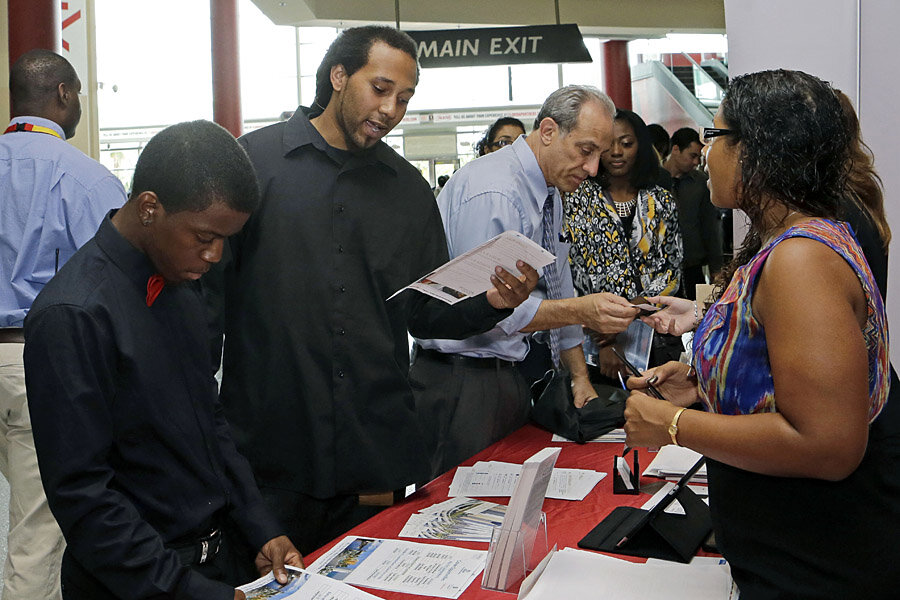US job openings near 13-year high. Why companies picked up hiring.
Loading...
The number of U.S. job openings remained near the highest level in 13 years in July, and companies also stepped up hiring that month to the fastest pace in nearly seven years, two signs the job market is slowly healing.
The tally of available jobs ticked down 2,000 to 4.67 million in July, the Labor Department said Tuesday. The drop was led by a decline in government job postings. Businesses actually advertised slightly more jobs.
Total hiring, meanwhile, jumped 81,000 to 4.87 million, the highest level since December 2007, when the Great Recession began. That indicates companies are more likely to fill their open jobs. Still, that is below the pre-recession average of just over 5 million hires a month.
The figures suggest the job market is still making progress, despite last week's mildly disappointing employment report. That report showed that employers added a net total of just 142,000 jobs in August, the fewest since December. The unemployment rate fell to 6.1 percent from 6.2 percent, but only because some of those out of work gave up looking. The government doesn't count people as unemployed unless they are actively searching.
Research by economists at JPMorgan Chase has shown that a rise in openings is typically followed 1-2 months later by greater net job gains.
"With the number of jobs available still near a 13-year high, the slowdown in net hiring exhibited in the August payrolls report is likely to be short-lived," John Silvia, an economist at Wells Fargo, said in a research note.
Job openings fell in manufacturing and construction, while they rose in retail and hotels and restaurants.
Tuesday's figures come from the Job Openings and Labor Turnover survey, or JOLTS, which provides a more detailed look at the job market than the employment report. It reports figures for overall hiring, as well as the number of quits and layoffs. The monthly jobs figures are a net total of job gains or losses.
The JOLTS data was a welcome sign after an underwhelming August jobs report. released last week. As the Monitor reported Friday, August job growth was the economy's worst in eight months:
The US economy added 142,000 jobs last month, nudging the unemployment rate down to 6.1 percent, according to data released Friday by the Bureau of Labor Statistics (BLS). That was far worse than the 210,000 on average that economists were expecting, and the job market’s weakest growth rate in eight months. The underwhelming report broke the economy’s streak of six straight months of 200,000 jobs added or more.
“Although the summer saw robust economic growth, job creation has slowed alongside as worries about the global economic outlook have intensified,” Chris Williamson, US economist for Markit, wrote via e-mailed analysis. “Furthermore, in a sign that plenty of slack persists in the labour market, wage growth remained subdued.”
The unemployment rate did tick down 0.1 percent, but mainly because more people stopped looking for work, opting out of the labor force. Additionally, the Labor Department revised jobs added in June and July downward, to the tune of about 28,000.
Federal Reserve Chair Janet Yellen is closely following the JOLTS data as she considers when the Fed should begin raising interest rates.
Job openings have soared 22 percent in the past 12 months, evidence that employers are confident enough in the economy to boost staffing. Net job gains have also increased strongly: Employers added more than 200,000 jobs a month for six straight months through July, the best such stretch in eight years.
But overall hiring, as measured by the JOLTS report, hasn't increased as fast as openings. Hiring is up just 8 percent in the past 12 months.
The gap suggests that some employers are having trouble finding workers with the skills they need. Or they may not be offering sufficient pay to attract the necessary applicants.
The number of Americans who quit their jobs last month was little changed, at 2.5 million, the JOLTS report showed. More people quit their jobs in a healthy economy because they are more likely to find new, typically higher-paying, jobs. Quits fell sharply in the recession but have since recovered. Yet they are still below the 2.8 million that is typical in a healthy economy.





